President's Message
On Saturday, August 18, the Henrico County Historical Society hosted the Ancestry Research Workshop at the Henrico Theatre. The presenters / speakers were Phyllis Silber, JoAnn Meaker, John Shuck, and Mary Ann Soldano. Each gave an amazing presentation, well-received by attendees. I would like to introduce them to you.
Phyllis Silber was the executive director of the Goochland County Historical Society beginning in May of 2000 and has recently retired. Phyllis previously retired from the Montgomery County school system in Maryland as a high school science teacher. She holds graduate degrees from the University of Tennessee and the University of Maryland. She can trace her maternal and paternal roots back to Goochland County in 1735. Her book, Under Every Tree: A Guide to Finding Your Roots in Virginia, was nominated for an NGS book award in 2017.
JoAnn Meaker was born in Brooklyn, raised on Long Island and spent almost 30 years in a small town in Western New York before relocating to Richmond in 2010. She’s a retired educator, author, historian and family genealogist who researched her family history for the past 20 years. She has incorporated this research into historical non-fiction novels, My Dear Emma and Four Branches. She inserted her family history into a story about someone in modern day doing research. She also wrote a non-fiction book, Stories Beneath the Stones: Richmond National Cemetery.
John Shuck grew up on a small farm in rural Iowa and, in his own words, has been visiting cemeteries for as long as he can remember. He's been doing genealogy research for over 50 years and has recently delved into DNA research. He has also been working for at least 10 years clearing, researching and mapping cemeteries in the area including East End and Evergreen cemeteries as well as other small cemeteries in the city and County. John has become quite the local celebrity, his work mentioned in many publications. The most recent was in the Richmond Times-Dispatch, "Discover Richmond" supplement. John has been on the Henrioc County Historical Society Cemetery committee for several years. John also represents the Brookland District on the Historic Preservation Advisory Committee. He has been the recipient of the HPAC Award of Merit for restoration work at East End Cemetery, and he received the 2016 Peter H. Brink Award for Individual Achievement in Historic Preservation from the National Trust for Historic Preservation.
Mary Ann Soldano is the archive researcher and Henrico County Planner. Mary Ann provides Henrico County review of development plans, rezoning cases and demolition requests. She assists with public research requests. Mary Ann is the go-to person for anything on the ground in Henrico County. She assisted to Henrico County Historical Society ladies, Sue Krimm and Margaret Childress, who called themselves the One Foot in the Grave Committee, gathering cemetery information. Mary Ann used Global Positioning System to provide the coordinates for the unmarked and private cemeteries. With the use of GIS (Geographical Information System) the known cemeteries in Henrico County were mapped. There are currently 205 cemeteries recorded in the database, and the information is used by many County agencies and for all the development reviews. A cemetery book was published in 2005. The efforts lead the way to the first comprehensive cemetery inventory, which is maintained with additional information still being added.
If you were unable to attend the workshop, books written by Phyllis Silber and JoAnn Meaker may be purchased online. If there are questions about a family cemetery or property in Henrico County, John Shuck and Mary Ann Soldano have assisted in many searches.
The mission of the Historical Society is to preserve the past in the present for the future. We are very grateful to our presenters, attendees and volunteers who participated in the workshop and continue the search of the past for future generations.
And so... on to the next project!
Sarah Pace
President
>Back to Top<
September Quarterly Meeting
Sunday, September 9, 2018 starting 2:30PM.

Confederate Hills Recreation Center, 302 Lee Avenue, Highland Springs, VA
Tom Robinson will talk about:
- The Battle of Cricket Hill underwater exploration
- History of Yuengling Brewery in Henrico
- First US Navy destroyer and several other military and civilian ships built on the Richmond/Henrico line in the Trigg Shipyard
Photo courtesy County of Henrico government.
See you there!
>Back to Top<
All About the Monocan Tribe
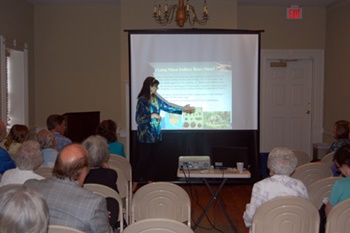
Kareene Wood addresses the HCHS at the June meeting at Walkerton Tavern.
>Back to Top<
In Memoriam
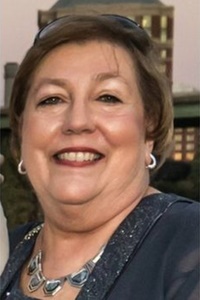
Linda Allen Dickerson, former Vice President of the Henrico County Historical Society, passed away July 24, 2018.
>Back to Top<
Five Years of Reclamation at East End Cemetery
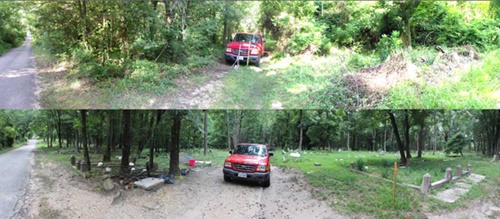
July marked the fifth anniversary of the clearing and maintenance project coordinated by John Shuck at East End Cemetery, and the results can be seen in the two panoramic photos seen above.
The site occupies 16 acres, approximately 13 of which are suitable for burials; and about half of that has been cleared.
Over the five years, there have been approximately 7,500 volunteer visits and approximately 350 work days.
As a result of the work, almost 3,000 readable grave markers have been uncovered.
Photo by John Shuck.
>Back to Top<
Wandering Through History - From Cures to Cricket
In The Fellowship of the Ring, J.R.R. Tolkein includes a poem with the following lines:
All that is old
does not glitter
Not all those
who wander
are lost.
Having wandered through local history and shared my travels through this newsletter for several years, I must aree with Tolkein. I keep hearing familiar names, passing familiar places, vicariously attending events that share some link to a previous journey or send me on a new one. For me, those names and places and events are golden, though rarely glittery, and remind me that no matter where I wander in research, I am never really lost.
So, wander with me through some seemlingly random aspects of Henrico's past, guided as I was by surprising links among them.
The journey begins with a look at a few Henricoans' participation in what was growing into a major industry in the mid-nineteenth century-patent medicine. One entry in the list of local patent or proprietary medicines claimed to be a cure for piles, or hemorrhoids. Touted as "A Certain Cure for Piles!" in an ad in the 15 June 1849 Richmond Enquirer, Henrico Pile Lotion supposedly had been "used by more than two hundred persons in this city, has fully proven to be the best, most simple and powerfully efficacious remedy for this most annoying disease ever yet discovered." It was available through Richmond's Chas. Bennett & Co., who offered "References ...from persons well known in our city, as well as many others, whom delicacy prevents from appearing in public.
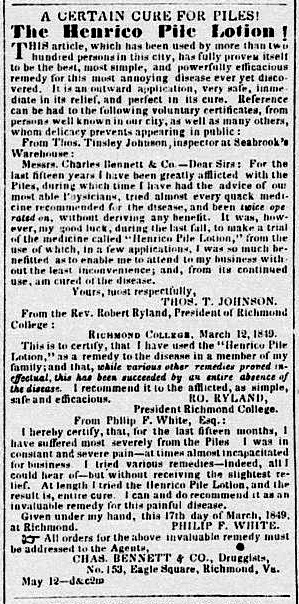
A local figure who was not hesitant to discuss such an indelicate topic was one Thomas Tinsley Johnson, identified in the ad as an inspector at Seabrook's Warehouse. Here was a link, however, thin, to one of our previous wanderings in Henrico history, the September 2017 article on the Payne Limner. Aside from the ten portraits this untrained itinerant artist had executed for the Payne family, he also painted five portraits of the family of Nicholas Brown Seabrook, a prominent Henrico family. Johnson lauds the medicine in the following testimonial: "For the last fifteen years I have been greatly afflicted with the Piles, during which time I have had the advice of our most able Physicians, tried almost every quack medicine recommended for the disease, and been twice operated on, without deriving any benefit. It was, however, my good luck, during the last fall, to make a trial of the medicine called 'Henrico Pile Lotion,' from the use of which, in a few applications, I was so much benefitted as to enable me to attend to my business without the least iconvenience; and, from its continued use, am cured of the disease."

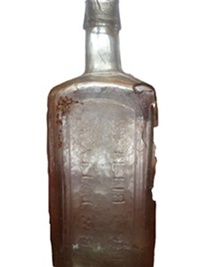
Henrico resident Benjamin W. Toddy promised far more extensive benefits from Totty's Superior Tonic Bitters. This grocer and later saloon keeper offered pint bottles of the elixir from 103 Cary Street; and in an advertisement in the 17 December 1857 Daily Dispatch, he recommended it "for the cure of dyspepsia, ague and fever, cholic, cramps of the stomach and bowels, nervous and general debility, langar [sic], lowness of spirits, diarrhea, &c." At fifty cents a bottle, this seems like a real medical bargain.
B.W. Totty's Superior Tonic Bitters, as advertised in the 17 December 1857 Richmond Dispatch, was sold for fifty cents in bottles like that seen above, identified at peachridgeglass.com as an extremely rare bottle.
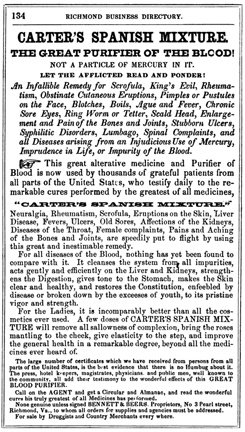
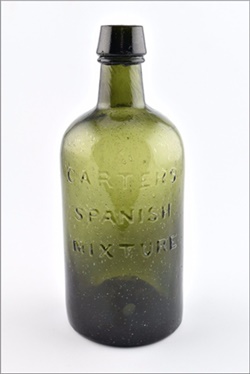
Perhaps the greatest claims for a local patent medicine, however, came from Main Street druggists Bennett & Beers, a partnership involving William S. Beers and the Henrico Pile Lotion. In the 12 June 1852 Daily Dispatch, they offered Carter's Spanish Mixture, what they claimed to be "The Greatest Spring Medicine" and indicated that to justify their claims of its efficacy, "Numbers of certificates from gentlemen of the first respectability could be given, but as the article is made in the county of Henrico, any one not acquainted with the medicine can see the maker in person" and those gentlemen would undoubtedly back the claim that it "will be found the best medicine for the Spring which can be used, or has ever been tried."
Carter's Spanish Mixture, advertised in many places like the 1855 Statistical Gazetteer of the Sate of Virginia seen above left was sold in bottles like that seen above right. This particular bottle is dark green with the product name in raised letters, and it sold at auction for $200. Other versions of this bottle were amber, and some had paper labels.
So called spring medicines had a long history in the world of patent medicines lasting into the earliest twentieth century as this 12 March 1901 ad from the Richmond Times for a different such product explains: "In the spring, everybody needs to think about taking a spring medicine.
Not only is this a common practice, but a very necessary and healthful one. It is a fact which physicians acknowledge and the people recognize generally, that a spring tonic taken during the months of March, April and May is more conducive to the restoration of health, in cases of those who are sick, than any other course of treatment that could possibly be adopted.
In the spring there are a great many and important changes going on in the body. Perfect health cannot be maintained while the system is clogged and the organs sluggish, and the person has a languid and weakened feeling, with more or less nervousness and debility. Therefore everybody should take a good spring remedy."
But Carter's Spanish Mixture did even more than the ordinary spring medicine. An ad in the 1855 Statistical Gazetteer of the State of Virginia assured readers that this "Great Purifier of the Blood" provided "An Infallible Remedy for Scrofula, King's Evil, Rheumatism, Obstinate Cutaneous Eruptions, Pimples or Pustules of the Face, Blotches, Boils, Ague and Fever, Chronic Sore Eyes, Ring Worm or Tetter, Scald Head, Englargement and Pain of the Bones and Joines, Stubborn Ulcers, Syphilitic disorders, Lumbago, Spinal Complaints, and all Diseases arising from an Injudicious Use of Mercury, Imprudence in Life, or Impurity of the Blood."
Of course, delicacy was an issue in product endorsements here as they were for the Henrico Pile Lotion. The above-cited Daily Dispatch ad claimed that Carter's Spanish Mixture "will cure Syphilis in the primary and secondary stages, as can be testified to by hundreds of grateful patients whom delicacy forbids naming in public." It is rather curious that those hundreds of grateful patients did not observe the same delicacy in the behavior causing the contraction of the condition.
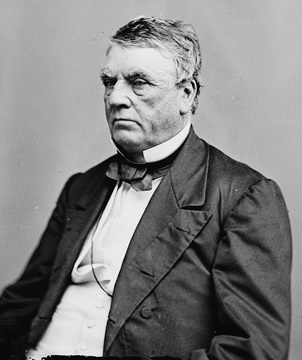
However, one testimonial for the product came from a figure familiar to those interested in nineteenth century Virginia politics, and it provides an unexpected turn in our wandering through Henrico history. John Minor Botts represented Henrico County in the Virginia House of Delegates from 1833 to 1838 and served in the U.S. Congress as a Representative from 1839 to 1843 and from 1847 to 1849. An ardent Unionist, a Whig and later a Know Nothing, he was even the object of an 1858 movement to nominate him for the Presidency. So his opinion apparently carried some weight outside the immediate area, explaining why a "letter from Hon. John Minor Botts." appears in the 7 January 1856 edition Washington, D.C's Evening Star. In the letter addressing Messrs. Wm. S. Beers & Co., Botts wrote, "Without being disposed or deeming it necessary to go into the particulars of the case, I say that the astonishing results that have been produced by that medicine on a member of my own family and under my own observation and superintendence, after the skill of the best physicians had been exhausted, and all the usual remedies had failed, fully justify me in recommending its use to all who may suffer from that dreadful malady [apparenly Scrofula]."
Botts was becoming increasingly controversial, even later being jailed by Confederates for his views and for entertaining Union officers; so it is perhaps understandable that his testimonial appears in a Washington paper and could not be found in a Richmond journal. However, it is through Botts that our attention turns from medicines to sports.
The portrait above on the right is John Minor Botts, Henrico politician, U.S. Representative and staunch Unionist, who wrote a testimonial for Carter's Spanish Mixture, providing a surprising and serendipitous link to cricket in Henrico County.

Botts' niece, Jane Botts of Richmond, had married Henry Chadwick, an Englishman who was a sportswriter in New York. For his contributions to baseball journalism, his innovations in statistics, the development of the baseball box score and his contributions to the rules of the game, he was eventually inducted into the Baseball Hall of Fame. He is even credited with introducing the "K" as the symbol for strikeouts. Additionally, Chadwick edited John Botts' work entitled The Great Rebellion. He and Jane resided in Richmond before the Civil War, and he avidly pushed for the establishment of baseball in the area, as well as cricket, the sport that apparently brought him to baseball. Returning to New York when the war began, he expressed in the New York Clipper his surprise and disappointment that Richmond had not yet formed any baseball clubs.
At right is a plaque of Hall of Famer, Henry Chadwick, New York sportswriter and promoter of cricket and baseball in Richmond, was married to John Botts' niece and edited Botts' The Great Rebellion.
It would not be long, however, before local interest in baseball blossomed, but it would take about forty years before evidence of interest in cricket clubs in the area would be shown. The 1 June 1900 Richmond Dispatch noted that "The first cricket club of Richmond was organized recently by thirty enthusiasts of the game." According to the report, A. L. Forbes' team outscored W. O. Wilkinson's team 117-60, not exactly a baseball score.
Then Henrico entered the cricket picture. Just two days later, the Richmond Times of 3 June 1900 reported under the heading "Henrico Team Won" that "The Richmond Cricket Club played an interesting game against the Henrico Cricket Club yesterday on Fulton Flats." It notes, someonewhat puzzlingly, that the teams were composed of men picked by the same Forbes and Wilkinson, so the organization of the clubs is not clear. Wilkinson's team won by 33 runs, so his was obviously the Henrico team, and its roster included the following men: Geo. Copeland, Wm. S. Smith, George D. Rust, Chas. Hill, Wm. Beck, W. A. Farrish, J. Haysom and Chas. Mann. (We would be most appreciative of any information readers might be able to offer about these people or the Henrico Cricket Club)
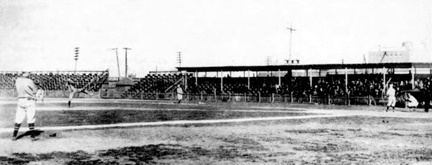
Pictured above: Broad-Street Base Ball Park, located between Allen and Lombardy Streets, this field also hosted some of the cricket matches between the Henrico Club and the Richmond Club. Photo from Baseball in Richmond by Ron Pomfrey.
The two teams played again, this time a one-inning game, on 9 June 1900 at what were named the Exposition Grounds, and thw next day's Times reported that Richmond won by 34 runs. Then on 24 June 1900 the Times covered a Richmond Cricket Club game at the Broad-Street Park, offering a tantalizing detail that hinted at yet another connection to a notable Henrico citizen. The article said, "Mr. Jack Cussons, an old cricket player, has recently joined the team and will make a strong acquisition to the club." Did Captain John Cussons, developer of Forest Lodge in Glen Allen, play cricket? He was sometimes referred to as Jack, as he was from England, and certainly at a bit over sixty he could be called "an old cricket player." But the Richmond Dispatch of the same day clarified the man's identity. The article explained that "The feature of the game was the batting and bowling of Mr. Jack Cussons, a new member from Mineral." Unfortunately, in all wanderings, there is the occasional wrong turn, and this turned out to be one; but as we said of the Henrico team members, we would like to know if there is a family relationship.
At any rate, June and July of 1900 contains several more references to Henrico Cricket Club games played including a 54-38 loss to the Richmond Club described by the 5 July 1900 Richmond Dispatch as "a fast and interesting game at the ball grounds yesterday, despite the hot weather."
And as delicacy was important to the advertising of patent medicines, so formality and propriety figured in cricket matches. Although the teams are not named, a notice in the 30 June 1900 Richmond Dispatch announced, "A cricket match will be played on their grounds (Broad-Street Base-Ball Park) this afternoon at 2:30P.M. Admission free. The ground has undergone many improvements; the seats in the grandstand will be dusted and made ready for the enjoyment of ladies.
It seems a bit odd that after the burst of cricket action in the summer of 1900, references to cricket matches disappear. But by that time, baseball had taken firm root in the area, and that brings us to a third request. In a brief announcement in the 30 July 1922 Richmond Times-Dispatch, there is the following announcement: "The Laurel team of the Henrico County Baseball Leaue challenges any amateur team in or around Richmond. Address George E. Harvey, Manager, School, Va." Any information about that league or team would be most welcome.
And so, having started out sampling some local curatives, we somehow have wandered to a circket field. I hope I didn't lose you, that the journaey was enjoyable and that this glimpse of less-than-glittery Henrico history provided a few gold nuggets.
Joey Boehling
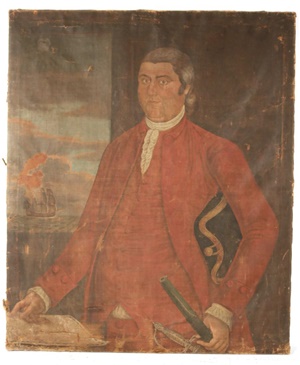
Nicholas Brown Seabrook. This prominent eighteenth century Henricoan established the warehouse, in which Thomas Tinsley Johnson later worked as an inspector. Johnson's testimonial for Henrico Pile Medicine in the 10 July 1849 Richmond Enquirer (seen at the right) provides a link to the September 2017 newsletter article about the Payne Limner, the artist who painted the portrait above and the portraits of four other family members. Theose portraits have surfaced in New Oxford, PA at Kelly Kinzle Antiques for an incredible $295,000.
>Back to Top<
Inventive Henricoans

Since the main article in this issue lightly touched on baseball, it seemed appropriate to include an invention on that theme - Samuel R. Crowder's Base-ball Game - Illustrating Apparatus. According to the patent, it was designed for " graphically illustrating to an audience the progress of a game of base-ball at a distance from the place where the game is played; and it consists essentially, of a support representing a field and slotted in various directions to permit the various places to be shown in combination with a series of movable figures or symbols representative of the players and the ball, said figures being adapted to be moved in the slots by the hand of an operator concealed behind the board representing the field, this operator receiving instructions for the various plays by telegraph where by the principle plays in the game may be readily and graphically illustrated or indicated." While many complain today that baseball on television is too slow to be entertaining (a claim herein rejected), the pace of a representation through this apparatus must have been absolutely snail-like.
>Back to Top<
Now You Know ... Getting All Sudsed Up
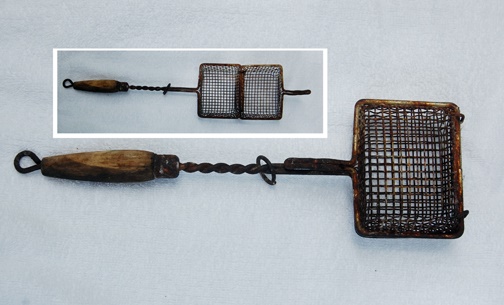
It is always interesting to read reader responses to this column, and our item for the last newsletter was no exception. A number of readers thought it might have been a toaster for the fireplace or a popcorn popper, and it does resemble one; however, given its size, it would only produce a mouthful and a severely burned hand.
Congratulations to Anne W. Jackson, who wrote to say, "Put all of your soap scraps in the basket and use them - it is called a 'soap saver'!" And after an obscure hint, Mary Jo and Hayward Wigglesworth also identified the object. The item is also known as a suds maker because it is loaded with soap scraps, it is swished around in the water to produce suds.
And while it's not a particularly early object, we thought it might be interesting to include a recipe for soap from the 1860 addition of Mary Randolph's The Virginia Housewife.
To Make Soap
Put on the fire any quantity of lye you choose that is strong enough to bear an egg - to each gallon, atdd three quarters of a pound of clean grease; boil it very fast, and stir it frequently - a few hours will suffice to make a good soap. When you find by cooling a little on a plate that it is a thick jelly, and no grease appears, put in salt in the proportion of one pint to three gallons - let it boil a few minutes, and pour it in tubs to cool - (should the soap be thin, add a little water to that in the plate, stir well, and by that means ascertain how much water is necessary for the whole quantity; very strong lye will require water to thicken it, after the incorporation is complete; this must be done before the salt is added.) Next day, cut out the soap, melt it, and cool it again; this takes out all the lye and keeps the soap from shrinking when dried. A strict conformity to these rules, will banish the lunar bugbear, which has long annoyed soap makers. Should cracknels be used, there must be one pound to each gallon. Kitchen grease should be clarified in a quantity of water, or the salt will prevent its incorporating with the lye. Soft soap is made in the same manner, only omitting the salt. It may also be made by putting the lye and grease together in exact proportions, and placing under the influence of a hot sun for eight or ten days , stirring it well four or five times a day.
>Back to Top<
What Do You Know?
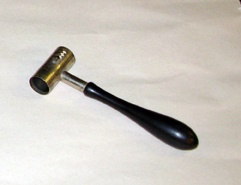
This wooden-handled item is 4 3/4" long. The plated metal tube on the end is about 1 3/4" long with a 3/4" internal diameter. There is a slot with notches on the tube, and inside it is a cup that moves up and down.
Do you know what it is?
Email your answers to:
jboehling@verizon.net
We thank our regular "What do you know?" participant and identifier Haywood Wigglesworth for supplying us with the mystery object for this issue. If you have an interesting item that you think would be a good subject, please let us know. We look forward to hearing from you. Show us what you've got.
>Back to Top<
News 2018: Third Quarter
First Quarter | Second Quarter | Fourth Quarter
Home | Henrico | Maps | Genealogy | Preservation | Membership | Shopping | HCHS
|











